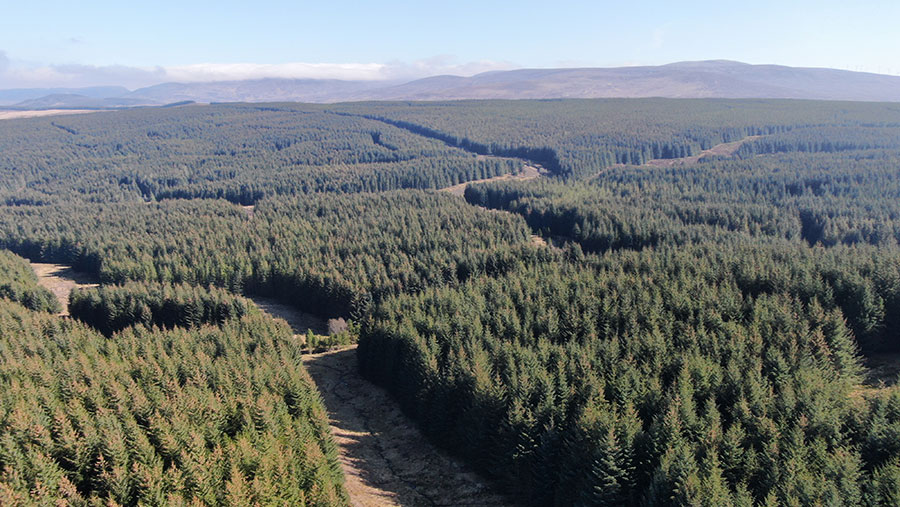6 things we know about the 2020 farmland market
 Badvoon Forest is available for offers of more than £5.75m © Clegg & Co
Badvoon Forest is available for offers of more than £5.75m © Clegg & Co Record-breaking low supply, rising demand, and buyers and sellers who had to break from the norm are all elements that have stood out for the land market so far in 2020.
Just 11,437 acres have been publicly advertised this year in the pages of Farmers Weekly, down 80% on the same time in 2019.
The market was hit hard by the coronavirus pandemic and the surrounding restrictions, but land remains a stable asset and its players determined.
See also: Why we’re selling the family farm during coronavirus
1. Steep drop in supply
Angus Locke, of Savills’ rural research team, said publicly marketed farmland looks set for a record-breaking low in 2020, with the pandemic’s lockdown hugely affecting activity.
Savills data to the end of May 2020 show Scotland saw the largest decrease, with a total of 2,600 acres marketed – 77% down on the 10-year average.
Wales showed a 30% decrease, with 2,500 acres advertised, while England, making up 73% of the farmland supply, was lower by 67%.
The average size of farms marketed was also down, averaging 126 acres during the same period compared with the 10-year average of 205 acres.
“Potential sellers of farmland are cautious and without pressures to sell – often rare in this market – the inclination for many is to wait until a fully functioning or confident market returns,” says Mr Locke.
2. Covid-19 delivered complications
The lockdown restrictions imposed by the government to prevent the spread of Covid-19 stalled the market for many between March and June.
Agents and vendors had to be innovative and more flexible if they pressed on with plans to launch farms during the spring, with online tools such as virtual tours becoming key. The market for blocks of land, in contrast, remained strong.
Where the transaction was well under way before the lockdown, or where the buyer was a neighbour who already knew the land on offer, deals were still able to come to completion smoothly.
Once social-distancing restrictions were further eased in mid-May, all agents reported a substantial number of requests to view properties and an increase in farm launches.
“Analysis of Savills website traffic has shown interest in rural property is up 50% on pre-lockdown levels,” says Mr Locke.
“The search terms ‘farms’ and ‘estates’ are now well above the pre-lockdown levels.”
3. Demand runs on
Long-term high demand for farmland has left buyers increasingly frustrated and hungry for opportunities.
Commercial farms, be it for sale or let, have received strong interest, as have those with environmental service delivery potential, says Mr Locke.
The pandemic has prompted many buyers to reconsider what they desire when purchasing a property.
A recent Savills survey of 660 respondents showed 49% felt the amount of garden or outside space had become more important since the lockdown period. A village or countryside location now seems more attractive to 40%, increasing to 50% for those with school-aged children.
“For this reason, interest remains strong for lifestyle and amenity properties, particularly among those with proximity to London,” says Mr Locke. “Evidence of buyers looking further afield for better-value property across northern England and Scotland is also apparent, and may also be a factor of pent-up demand.”
Meanwhile, the commercial conifer market is particularly robust, with demand originating from institutional (both UK-based and international) and quasi-institutional buyers, private investors, and, to a lesser degree, end-users of timber.
4. Steady land values
No agent is currently reporting any change to average values, as there is so little new market evidence.
The land market has a strong track record of not being very affected in terms of economic uncertainty.
5. Rural areas setting records
Markets outside of the capital are currently setting records for number of offers accepted (the highest on record in the week to 6 June and up 52% on the five-year average) and number of new prospective buyers (the highest it has been since May 2018 and 14% ahead of the five-year average, in the week ending 6 June).
This is due to price and an increase in buyers seeking outdoor space, said David Peters, head of country business at Knight Frank.
“The average discount to the asking price for sales outside London is 1.2% since the market reopened, compared with 2.4% during the lockdown,” he says.
“While web views for London properties were 13% below the five-year average in the week ending 6 June, outside London there was a 13% increase.”
6. Buoyant forestry market
The commercial forestry sector has remained buoyant during lockdown at a time when people are increasingly concerned about carbon trade and the benefits of natural capital, says specialist forestry agency John Clegg & Co.
There is significant interest in planting land opportunities and marginal upland sites, whereas amenity woodlands and broad-leaves are less popular.
The firm is launching 13 woodlands across the UK, amounting to more than 5,931 acres and a combined asking price of more than £10.7m.
Badvoon Forest, a 1,799-acre commercial conifer forest near Ardgay in Sutherland, is available for offers of more than £5.75m.
It includes a substantial volume of maturing timber and benefits from a good internal road network and proximity to key timber-processing facilities in the north of Scotland.
